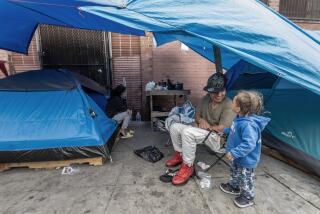Somalis Find Home, Hope in Minnesota
MINNEAPOLIS — It is lunch hour, and Abdinasir Mohamed rushes to put roasted goat meat and spiced rice on his customers’ tables at his downtown storefront restaurant.
In many ways, his customers are no different from those he served at his first cafe, the one he built from blue plastic sheeting and scrap wood in a Somali refugee camp in Kenya--seven years ago, after he escaped from the clan fighting and warlords in Mogadishu.
“[In the camp] the United Nations lady gave us maize meal, but Somalis don’t eat maize,” Mohamed explains. “I asked for something else, but she said, ‘That is all there is.’ ”
Back then, Mohamed bribed the police to let him go buy goat meat and bring it back to the camp. Today, Mohamed is still improvising to help his fellow refugees adapt from the arid and impoverished Horn of Africa to the cold plains of the world’s wealthiest country.
He calls his latest restaurant Safari, which in Swahili means journey. Like many Somalis in America, Mohamed’s journey has taken him away from clan rivalry and toward a new national identity.
Mohamed is among about 20,000 Somali refugees in the United States--12,000 of them in Minnesota.
Yes, Minnesota. In refugee camps and upon their arrival in the United States, Somalis heard about food-processing jobs in a Land of 10,000 Lakes, and so they came.
They were fleeing clan warfare that erupted after the collapse of President Siad Barre’s totalitarian regime in 1991.
Clan divisions still fuel violence and chaos in Somalia. But clan loyalties have lost their grip on Somalis in the United States.
Ahmed I. Samatar, professor and dean of international studies at Macalester College in St. Paul, emigrated from Somalia 23 years ago. He is an expert on Somalia and helps refugees in Minnesota.
“The new habitat requires a new method of identifying themselves by another means, not by kinship,” Samatar said. “Like any group of refugees, they huddle together here against a larger culture.”
Somalis share a common language, religion and ethnicity that should make national unity easy, Samatar said. He says Somalis are impressed with American diversity.
“I think it gives Somalis a very sobering lesson, that so many different kinds of people can live together,” Samatar said. “Kinship is no longer so important. It’s now Somalis in the face of other groups.”
No clan-motivated violence has been reported in Minnesota.
Here, Mohamed said, “we are no longer concerned; we are all friends.”
Somali culture and Islamic practices set Somalis apart from Americans. Somali women wear traditional long dresses with scarves or veils. Most Somalis also follow Islamic law, which prohibits alcohol, drugs and premarital sex and carries severe criminal penalties.
To promote their values, the Somali community has formed its own mosque, cultural organizations and community programs. Most Somalis are grouped in two low-income areas of Minneapolis or in rural areas.
Fewer than 4% of the Somalis in Minnesota receive public assistance, making them among the most self-sufficient ethnic groups in the state. Mohamed Essa, director of the Somali Community in Minnesota, said he receives requests from employers and landlords every day asking for more Somali applicants.
“Even in the refugee camps, they know that if they come to America, there is opportunity in Minnesota,” Essa said. But although there is plenty of opportunity, there is little understanding, he said.
The role of women as authority figures in American society is different from Somalia, where few women work outside the home and men are not accustomed to taking instructions from women. Citing Islamic law, Mohamed refuses to shake hands with or touch any woman not in his family, a gesture that some American women find sexist.
One issue is female circumcision, which critics call genital mutilation. Somali custom requires some form of bloodletting near the clitoris for a girl to reach womanhood. The practice is illegal in the United States.
“Now that it is illegal, no one will talk about it in public. But some still want it done,” Essa said. “So many young mothers do not want to circumcise their daughters, but there is an argument between the new generation and the old generation.”
Somalis intent on carrying out the practice will sometimes travel back to Africa to have it done, or merely pinch the hood off an infant’s clitoris with their fingers, Essa said.
But most Somalis say they are quitting the practice; no cases have been recorded in Minnesota.
Somalis also practice corporal punishment, and many complain that child protection workers are too quick to take away their children. Somali leaders are working with authorities to educate them about their culture.
In order to give their children an alternative place to socialize, the Somali Club in Minneapolis organizes weekly dances.
On a recent weekend, teens from different clans gathered to hear a famous Somali singer. About half the teens dressed traditionally, while the rest wore Western clothes. Ali Awor Sama, a Somali immigrant preparing to resettle permanently in Somalia, looked on disapprovingly.
“Look at them, they look like everyone else; you can no longer tell they are Somali,” said Sama, 27, who has lived in America for 15 years. “In three years they will change their minds. They will want to go back.”
But according to U.S. government statistics, more than 94% of Somali refugees have converted their refugee status to permanent resident status and are working toward U.S. citizenship.
“If the situation in my country becomes very cool, then I want to go back and start a business,” Mohamed said. “But America is my second country. I will always make a home here.”
More to Read
Sign up for Essential California
The most important California stories and recommendations in your inbox every morning.
You may occasionally receive promotional content from the Los Angeles Times.










